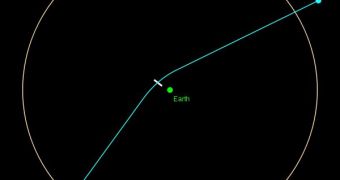The asteroid Apophis is one of the most feared and investigated pieces of space rocks in the skies at this point, because astronomers calculated in 2004 that it might be possible for it to hit the Earth in the near future, around 2036. Because the asteroid has twice the size of a football field, a collision with it would most likely bring forth another extinction event. Such a massive impact would increase the seismic and volcanic activity and would also bring about a new era of global cooling, with spews of ash covering up the Sun, Space reports.
In a new astronomical study, which was conducted using the University of Hawaii's 88-inch telescope, atop Mount Kea, in Hawaii, it was determined that the chances of Apophis actually hitting the planet, or passing dangerously close to us, were fairly slim, and that there was no reason to panic. The precision of the new observatory allowed the scientists to recalculate the rock's orbital path. Additionally, it was also determined that an impact would only cause regional devastation, and not a planet-wide extinction event, as first calculated. However, the impact would, indeed, be devastating.
“Apophis has been one of those celestial bodies that has captured the public's interest since it was discovered in 2004. Updated computational techniques and newly available data indicate the probability of an Earth encounter on April 13, 2036, for Apophis has dropped from one-in-45,000 to about four-in-a million,” near-Earth object scientist Steve Chesley, from the American space agency's Jet Propulsion Laboratory (JPL), in Pasadena, California, explains.
When the trajectory of the object was first calculated, it was determined that it had a 2.9-percent chance of colliding with the Earth in 2029. However, subsequent studies have shown that this year can be ruled out in terms of a potential impact. On Friday, April 13, 2029, Apophis will closely approach the Earth, passing only some 18,300 miles above the planet's surface, astronomers report. Another pass-by will take place in 2068, when the chances of an impact will be of about three in a million.
“The refined orbital determination further reinforces that Apophis is an asteroid we can look to as an opportunity for exciting science and not something that should be feared,” JPL Near-Earth Object Program Office Manager Don Yeomans adds.

 14 DAY TRIAL //
14 DAY TRIAL //